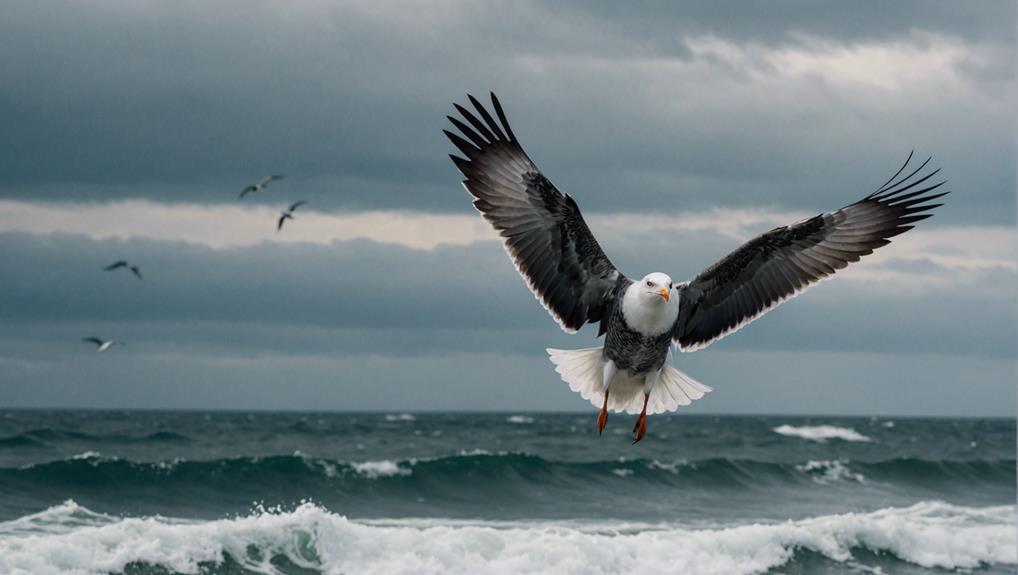Seagulls and crows often clash due to their similar habitats and scavenging diets, leading to frequent conflicts over food, especially in urban areas. Seagulls tend to dominate food sources and can initiate aggressive encounters, while crows respond defensively. These territorial disputes become more intense during nesting seasons, with each bird species using vocalizations to mark their turf. Crows, known for their intelligence and strong problem-solving abilities, choose strategic nesting locations to minimize conflicts. Both species are highly adaptable and resourceful, but their interactions can have a substantial impact on local ecosystems. Explore the intriguing dynamics of their interactions and how human activities affect them.
Natural Habitats
Both seagulls and crows exhibit distinct preferences in their natural habitats, with seagulls favoring coastal regions and crows demonstrating remarkable adaptability to diverse environments. Seagulls are most commonly seen near coastlines and bodies of water, thriving in open areas like beaches and harbors. Their preference for these locales is tied to their need for expansive spaces where they can easily take flight and scan for food. The salty breeze and rhythmic waves are integral parts of the seagull's daily life, making coastal regions their ideal habitat.
In contrast, crows are the epitome of adaptability. These intelligent birds can be found in a variety of environments, including wooded areas, parks, and bustling cities. Their ability to thrive in urban landscapes showcases their resourcefulness. Whether perched on a city skyscraper or hidden among the trees in a suburban park, crows exhibit an impressive capability to adapt to their surroundings. This adaptability allows them to navigate a wide range of habitats, from rural fields to metropolitan zones.
Despite these differing preferences, both species are opportunistic in nature, which sometimes brings them into the same general habitats, coexisting without significant conflicts.
Feeding Habits
Seagulls and crows exhibit differing yet overlapping feeding habits that often lead to competition and conflict over food sources. Seagulls are known as opportunistic feeders, scavenging for food wherever it is available, whether it be along shorelines, in open fields, or near human activities. They are not picky eaters and will consume fish, insects, and even human leftovers. Their opportunistic nature allows them to take advantage of a wide range of food sources.
Crows, on the other hand, are highly intelligent and adaptable birds. They are known for their problem-solving skills and their ability to steal food from other birds, including seagulls. Crows eat a diverse diet that includes insects, small animals, fruits, and human scraps. This adaptability makes them formidable competitors in the quest for food.
In urban areas, the clash between seagulls and crows becomes even more pronounced. Both species are drawn to the abundance of human-provided food, from garbage bins to picnic areas. Their encounters often lead to aggressive behaviors as they fight for access to these easy meals. This competition is a key factor in the strained relationship between these two bird species.
Territorial Behavior

Territorial behavior frequently intensifies conflicts between crows and seagulls, particularly during nesting seasons. These avian adversaries often clash when defending their respective territories or seeking food.
Crows, known for their assertiveness, typically exhibit more aggressive behavior, frequently chasing seagulls away from their established zones. Conversely, seagulls may attempt to scavenge food from crows, leading to further friction.
Both species utilize distinct vocalizations to assert and protect their territories. These calls serve as audible boundaries, signaling to others to keep their distance. In urban settings, where resources are often scarce, such territorial behaviors can lead to heightened confrontations.
These interactions can be visualized through the following scenarios:
- A crow swooping down on a seagull, chasing it away from a prized nesting site.
- Seagulls scavenging remnants from a crow's meal, leading to a noisy standoff.
- Both species using their unique calls to ward off intruders, creating a cacophony of sound.
- Urban landscapes turning into battlegrounds as both birds compete for limited resources.
Through these examples, it becomes evident that territorial behavior plays a significant role in the dynamic and often tumultuous relationship between crows and seagulls.
Nesting Preferences
Understanding the nesting preferences of seagulls and crows reveals much about their interactions and conflicts, especially regarding their choice of nesting sites. Seagulls are typically drawn to coastal areas, building their nests near water bodies like beaches and cliffs. They use debris such as seaweed and sticks to construct their nests. This preference for nesting in colonies offers them protection and social interaction.
In contrast, crows usually select tall trees or buildings in urban settings for their nesting sites. Their nests are intricate, made from twigs, grass, and different other materials. Unlike seagulls, crows are more solitary nesters, with one pair occupying a specific territory.
The differing nesting preferences often lead to interactions between the two species. Seagulls, known for their scavenging habits, may search for food near crow nests, potentially causing competition, especially during breeding seasons. Furthermore, crows exhibit strong territorial behavior around their nests, which may result in them driving away seagulls or other birds that come too close.
This dynamic interplay between seagulls and crows emphasizes the importance of nesting preferences in understanding their relationship, highlighting both the potential for conflict and the distinct ecological niches they occupy.
Aggression Levels

Examining the aggression levels between seagulls and crows reveals a complex dynamic influenced by competition for resources and territorial behaviors. Seagulls tend to be more aggressive towards crows, often dominating food sources and initiating conflicts. This aggressive behavior can lead to defensive responses from crows, who might employ diverse strategies to avoid direct confrontations.
Seagulls and crows interact in ways that highlight their differing levels of aggression:
- Food Competition: Seagulls frequently overpower crows at food sites, using their larger size and aggressive nature to secure resources.
- Defensive Tactics: When faced with seagull aggression, crows often display defensive behaviors, such as mobbing or vocalizing loudly to ward off their attackers.
- Territorial Disputes: Conflicts can escalate in areas where both species compete for nesting sites, with seagulls typically taking the upper hand due to their assertive territorial behaviors.
- Strategic Nesting: To mitigate these aggressive encounters, crows may choose nesting locations that are less accessible to seagulls, such as densely wooded areas or urban environments.
These interactions underscore the diverse aggression levels and adaptive behaviors of both species, shaped by the need to coexist and compete within shared habitats. Understanding these dynamics helps illuminate the broader ecological relationships between seagulls and crows.
Intelligence Comparisons
In comparing the intelligence of seagulls and crows, it becomes evident that both species exhibit remarkable cognitive abilities, albeit in different ways. Crows, for example, are renowned for their problem-solving skills and tool use. They can craft tools from sticks and leaves to retrieve food, showcasing a high level of ingenuity and foresight. Moreover, crows have a unique ability to recognize individual human faces, a trait that underscores their sophisticated learning capabilities.
Seagulls, on the other hand, demonstrate their intelligence through impressive adaptability and resourcefulness. They are adept at learning from their surroundings and experiences, quickly adjusting to new environments and finding creative ways to secure food. This resourcefulness is often seen when seagulls cleverly exploit human activities, such as scavenging in urban areas.
Both species also exhibit complex social behaviors. Crows frequently work in groups to achieve common goals, such as mobbing predators or solving intricate problems. Seagulls, too, can be seen cooperating, particularly when foraging for food. Despite their differences, these behaviors highlight a shared cognitive strength, allowing both seagulls and crows to successfully navigate and thrive in their respective habitats.
Adaptation Strategies

Both seagulls and crows employ distinct adaptation strategies to thrive in the face of competition and environmental challenges. These intelligent birds have developed different methods to secure their survival, particularly in urban environments where their interactions are more frequent.
- Resourcefulness: Crows are highly resourceful, using their problem-solving skills to find food. They are known to use tools to access food sources, including using sticks to dig insects out of crevices or dropping nuts on roads for cars to crack open.
- Opportunistic Feeding: Seagulls, on the other hand, are opportunistic feeders. They scavenge for food in a variety of places, from garbage dumps to beaches, and even steal food from humans. Their diet flexibility helps them thrive in different environments.
- Social Structures: Crows live in complex social structures, often forming tight-knit family groups. This social behavior aids in their survival as they can work together to fend off predators or other threats.
- Aggressive Tactics: Seagulls rely on aggressive tactics to protect their territory and food sources. They often mob intruders, including crows, in large groups to drive them away, showcasing their strong territorial instincts.
Through these strategies, both species have successfully adapted to the challenges posed by their environments, securing their continued survival.
Conflict Scenarios
Frequently, seagulls and crows find themselves embroiled in conflicts over shared food sources, leading to aggressive interactions in their overlapping habitats. These conflicts are particularly common in urban areas where both species are drawn to the same easily accessible food supplies.
Crows, known for their cunning and boldness, often harass seagulls to steal their food or disrupt their activities. This behavior can escalate quickly, with crows swooping down on seagulls mid-meal, creating chaotic scenes of flapping wings and loud cawing.
Seagulls, on the other hand, are not passive victims. They actively defend their nesting areas, chasing away crows to protect their territories. These confrontations can be intense, as seagulls use their size and numbers to their advantage, often ganging up on a lone crow. Both species exhibit a range of aggressive behaviors, from threatening postures to physical attacks, especially when the competition for food is fierce.
The intensity and frequency of these interactions can vary significantly depending on the location and the availability of resources. In some areas, where food is plentiful, these conflicts might be less frequent, while in others, scarcity can lead to heightened aggression and more frequent disputes.
Impact on Ecosystems

The interactions between seagulls and crows greatly influence the stability and composition of local ecosystems. Both species play significant roles in their respective environments, but their competitive nature can lead to notable ecological impacts. When seagulls and crows clash, the effects ripple through the ecosystem, leading to several significant outcomes.
Food Competition: Seagulls and crows often compete for the same food sources, which can lead to aggressive encounters. This competition can reduce the availability of food for other species, potentially altering the food web dynamics.
Nesting Site Conflicts: Both birds vie for prime nesting sites, creating territorial disputes. These conflicts can displace other bird species, affecting their breeding success and population stability.
Scavenging Habits: Seagulls are known scavengers, especially in urban areas, while crows adapt to a range of environments. This adaptability allows crows to exploit different food sources, sometimes outcompeting seagulls and other local wildlife.
Ecosystem Balance: The presence and behavior of seagulls and crows can disrupt natural processes, such as seed dispersal and pest control, leading to imbalances in the ecosystem.
Understanding these dynamics is essential for maintaining ecological harmony and managing bird populations effectively.
Human Influence
Human activities greatly influence the interactions between seagulls and crows, particularly in urban environments where food sources are plentiful. In cities and towns, waste from human settlements provides easy meals, attracting both seagulls and crows. This abundance of food often leads to increased competition, as both species vie for the same resources. For instance, discarded food in parks, streets, and garbage dumps becomes a hotspot for these birds, sometimes leading to conflicts.
Feeding seagulls at beaches is another human activity that impacts their relationship with crows. When people feed seagulls, it inadvertently attracts crows as well, further intensifying the competition. This can lead to more frequent interactions between the two species, often resulting in aggressive encounters as they scramble for the same morsels.
Urban environments not only change the availability of food but also alter the natural behaviors of seagulls and crows. Human presence in these areas can cause both birds to become more opportunistic and adaptable, often leading to changes in their feeding habits and social interactions.
Consequently, the dynamics between seagulls and crows are markedly shaped by the way humans influence their shared habitats.
Frequently Asked Questions
Are Crows Afraid of Gulls?
Crows are not inherently afraid of gulls, but they tend to avoid confrontations due to the gulls' larger size and aggressive behavior.
While both birds may compete for food and nesting sites in shared habitats, crows often employ different feeding strategies to coexist.
Their intelligence and adaptability allow them to find alternative resources, reducing direct conflicts.
Consequently, crows and gulls can inhabit the same areas with minimal friction.
Who Would Win, Seagull or Crow?
In a direct confrontation, crows are more likely to win due to their aggressive and territorial nature. Crows are known for their intelligence and coordinated mobbing tactics, which they use effectively to drive away competitors like seagulls.
Seagulls, while opportunistic feeders, generally avoid direct conflict and may back down when faced with a determined crow. Therefore, crows typically have the upper hand in conflicts over food and territory.
What Birds Are Seagulls Most Scared Of?
Seagulls are most scared of larger predatory birds such as eagles, hawks, and falcons. These formidable birds of prey can pose a significant threat to seagulls, targeting them or their chicks.
When these predators are nearby, seagulls often display alarm calls and engage in evasive maneuvers to protect themselves and their nests. Their wariness around these predators is a survival tactic to avoid becoming prey.
Do Crows Get Along With Other Birds?
Crows, known for their intelligence and social nature, often form strong bonds within their own species. While they generally coexist with other birds, they can be territorial and protective, especially around their nesting areas.
Interactions with different bird species, including seagulls, vary based on resource availability and environmental contexts. Territorial disputes or competition over food can lead to aggressive behaviors, but crows can also exhibit tolerance and coexistence under favorable conditions.

